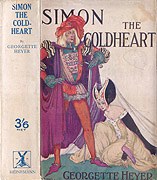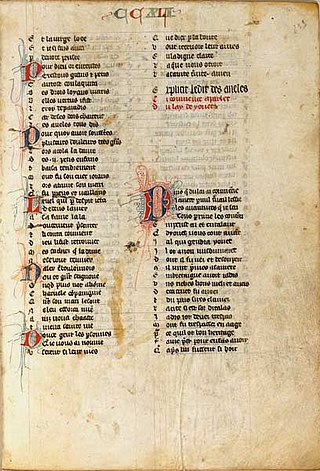This article relies largely or entirely on a single source .(May 2015) |
Old Robin of Portingale (archaic English for "Portugal") is a Child ballad [1] only found in the Percy Folio.
This article relies largely or entirely on a single source .(May 2015) |
Old Robin of Portingale (archaic English for "Portugal") is a Child ballad [1] only found in the Percy Folio.
It opens with a warning against old men marrying young women.
Old Robin of Portingale marries the daughter of the mayor of Linn. She soon goes to Sir Gyles and asks his help in murdering her husband. They make plans to attack him with twenty-four knights. His foot page overhears and weeps in the garden. When Robin asks what it is wrong, the page tells him. He promises to make him his heir if he tells the truth, and kill him if he lies.
He tells his lady that he is sick and lies down in bed in full armor. The twenty-four knights attack, and Sir Robin kills them all. He mutilates his wife for her part in the plot, makes the foot page his heir, and leaves to go on a pilgrimage to the Holy Land.

Sir Guy of Gisbourne is a character from the Robin Hood legends of English folklore. He first appears in "Robin Hood and Guy of Gisborne", where he is an assassin who attempts to kill Robin Hood but is killed by him. In later depictions, he has become a romantic rival to Robin Hood for Maid Marian's love.

"Matty Groves", also known as "Little Musgrave and Lady Barnard" or "Little Musgrave", is a ballad probably originating in Northern England that describes an adulterous tryst between a young man and a noblewoman that is ended when the woman's husband discovers and kills them. It is listed as Child ballad number 81 and number 52 in the Roud Folk Song Index. This song exists in many textual variants and has several variant names. The song dates to at least 1613, and under the title Little Musgrave and Lady Barnard is one of the Child ballads collected by 19th-century American scholar Francis James Child.
Richard at the Lee is a major character in the early medieval ballads of Robin Hood, especially the lengthy ballad A Gest of Robyn Hode, and has reappeared in Robin Hood tales throughout the centuries.
"Lady Isabel and the Elf Knight" is the English common name representative of a very large class of European ballads.
"The Fair Flower of Northumberland" is a folk ballad.
The Bonny Birdy is Child ballad 82.
"Young Ronald" is an old song catalogued as Child Ballad 304.
Robin Hood and the Valiant Knight is an 18th century ballad of the death of Robin Hood. The song, written in Modern English, was included in the popular "garlands" (collections) of Robin Hood stories and songs published in the 18th and early 19th centuries, generally at the end as a suitable close to the garland. It was later published by Francis James Child as Child ballad #153 in his influential collection of popular ballads.

A Gest of Robyn Hode is one of the earliest surviving texts of the Robin Hood tales. Written in late Middle English poetic verse, it is an early example of an English language ballad, in which the verses are grouped in quatrains with an ABCB rhyme scheme, also known as ballad stanzas. Gest, which means tale or adventure, is a compilation of various Robin Hood tales, arranged as a sequence of adventures involving the yeoman outlaws Robin Hood and Little John, the poor knight Sir Richard at the Lee, the greedy abbot of St Mary's Abbey, the villainous Sheriff of Nottingham, and King Edward of England. The work survives in printed editions from the early 16th century, just some 30 years after the first printing press was brought to England. Its popularity is proven by the fact that portions of more than ten 16th- and 17th-century printed editions have been preserved. While the oldest surviving copies are from the early 16th century, many scholars believe that based on the style of writing, the work likely dates to the 15th century, perhaps even as early as 1400. The story itself is set somewhere from 1272 to 1483, during the reign of a King Edward; this contrasts with later works, which generally placed Robin Hood earlier in 1189–1216, during the reigns of Richard I of England and John, King of England.
"Young Andrew" is a folk song catalogued as Child ballad 48.
The Knight's Ghost is Child ballad 265. It tells the story of a woman who learns that her husband has died in battle, after which she locks his men in a cellar and throws the keys in the sea. Her husband's ghost appears to ask that she release his men, assuring her they fought bravely. Francis Child drew the ballad from Buchan's Ballads of the North of Scotland.
Sweet William's Ghost is an English Ballad and folk song which exists in many lyrical variations and musical arrangements. Early known printings of the song include Allan Ramsay's The Tea-Table Miscellany in 1740 and Thomas Percy's Reliques of Ancient English Poetry in 1765. Percy believed that the last two stanzas of the version he published were later additions, but that the details of the story they recounted were original.
King Horn is a Middle English chivalric romance dating back to the middle of the thirteenth century. It survives in three manuscripts: London, British Library, MS. Harley 2253; Oxford, Bodleian Library, MS. Laud. Misc 108; and Cambridge, Cambridge University Library, MS. Gg. iv. 27. 2. It is thought to be based on the Anglo-Norman Romance of Horn (1170). The story was retold in later romances and ballads, and is considered part of the Matter of England. The poem is currently believed to be the oldest extant romance in Middle English.

Simon the Coldheart is a historical fiction novel by Georgette Heyer published in 1925. Not a typical Georgie Heyer regency story, it is a tale of chivalry, intrigue and conquest. Set in the medieval period during the Hundred Years' War between England and France, it is her fifth novel, and the first of only three set in that period.

"Yonec" is one of the Lais of Marie de France, written in the twelfth century by the French poet known only as Marie de France. Yonec is a Breton lai, a type of narrative poem. The poem is written in the Anglo-Norman dialect of Old French in rhyming couplets of eight syllables each. This lai tells the story of a woman who seeks to escape a loveless marriage, and of the child born from the love that she found elsewhere.

"The Dowie Dens o Yarrow", also known as "The Braes of Yarrow" or simply "Yarrow", is a Scottish border ballad. It has many variants and it has been printed as a broadside, as well as published in song collections. It is considered to be a folk standard, and many different singers have performed and recorded it.
Tyolet is an anonymous Breton lai that takes place in the realm of King Arthur. It tells the tale of a naïve young knight who wins the hand of a maiden after a magical adventure.

The Outlaws of Sherwood is a retelling of the legend of Robin Hood by Robin McKinley. In McKinley's afterword, she says, "The retellings through the centuries have echoed concurrent preoccupations." The story includes both the traditional Robin Hood characters — Little John, Much, Friar Tuck, Marian and Alan-a-dale — and characters of McKinley's own invention. Notably, three of the most important characters are women, all of whom escape marriage to prospective spouses chosen by their fathers.

The Tale of Gamelyn is a romance written in c. 1350 in a dialect of Middle English, considered part of the Matter of England. It is presented in a style of rhymed couplets and described by Skeat as "the older and longer kind of ballad" and by Ramsey as a "rough and ready romance."

The Story of King Arthur and His Knights is a 1903 children's novel by the American illustrator and writer Howard Pyle. The book contains a compilation of various stories, adapted by Pyle, regarding the legendary King Arthur of Britain and select Knights of the Round Table. Pyle's novel begins with Arthur in his youth and continues through numerous tales of bravery, romance, battle, and knighthood.